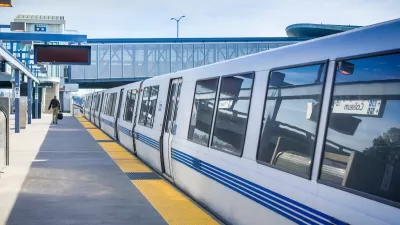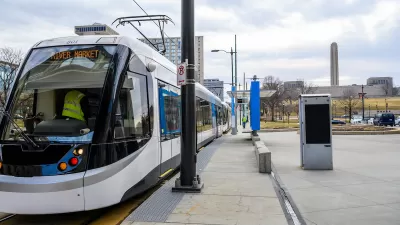S.F. historian Carl Nolte examines S.F.'s vibrant streetcar history and today's modern light rail replacements.
"Streetcars were (once) the clunkiest things in the world, expensive, noisy, old-fashioned. Nearly every big city in the country had them, and in the '40s and '50s, nearly every big city ripped up the tracks and junked the streetcars. They were dinosaurs. Now they are hip. How did that happen?
San Francisco was one of the few places that kept a few streetcar lines, mostly because the city fathers (no city mothers in those days) couldn't figure out a way to run buses through the Twin Peaks tunnel.
Streamlined cars - kids called them "Green Torpedoes" - gave the streetcars a reprieve in the '50s, but not until 1980, when the Muni Metro subway opened, did rail transit get off the endangered list.
But anybody who has lived here awhile knows how it is in San Francisco - out with the old! In with the new! Out with the new! Back to the old!
A generation later, San Francisco has emerged with a two-tier rail system - the modern Muni Metro, and the antique and highly successful F line, featuring old streetcars from around the world.
Now San Francisco's Muni carries close to 1 million customers a week on the rail lines. In the subway, it's not your grandfather's Muni. For one thing, Muni is big on the Internet. There is a site - the N-Judah Chronicles - devoted to life on the N line.
There are at least six blogs that deal with the agency at least some of the time. My favorite is MUNI Haiku. One sample from the J-Church line: "We stopped in the tunnel/we stopped in the tunnel again/nobody said a word."
FULL STORY: Riding the city rails

Maui's Vacation Rental Debate Turns Ugly
Verbal attacks, misinformation campaigns and fistfights plague a high-stakes debate to convert thousands of vacation rentals into long-term housing.

Planetizen Federal Action Tracker
A weekly monitor of how Trump’s orders and actions are impacting planners and planning in America.

In Urban Planning, AI Prompting Could be the New Design Thinking
Creativity has long been key to great urban design. What if we see AI as our new creative partner?

Pedestrian Deaths Drop, Remain Twice as High as in 2009
Fatalities declined by 4 percent in 2024, but the U.S. is still nowhere close to ‘Vision Zero.’

King County Supportive Housing Program Offers Hope for Unhoused Residents
The county is taking a ‘Housing First’ approach that prioritizes getting people into housing, then offering wraparound supportive services.

Researchers Use AI to Get Clearer Picture of US Housing
Analysts are using artificial intelligence to supercharge their research by allowing them to comb through data faster. Though these AI tools can be error prone, they save time and housing researchers are optimistic about the future.
Urban Design for Planners 1: Software Tools
This six-course series explores essential urban design concepts using open source software and equips planners with the tools they need to participate fully in the urban design process.
Planning for Universal Design
Learn the tools for implementing Universal Design in planning regulations.
planning NEXT
Appalachian Highlands Housing Partners
Mpact (founded as Rail~Volution)
City of Camden Redevelopment Agency
City of Astoria
City of Portland
City of Laramie





























